
Understanding seed-related processes is of major social, environmental, and economic concern. The viability and vigor of seeds are the very basis for sustainable agriculture and forestry, and comprehending the molecular and cellular events underlying these processes will become increasingly important to many economical sectors and for species that provide the world’s food supply. Seed Dormancy: Methods and Protocols covers analytical methods and approaches which have already lead to significant advances in the understanding of seed dormancy and germination. Chapters cover explanations of processes leading to the induction, maintenance, and termination of seed dormancy, the classification of different dormancy types, as well as an overview of protocols used for dormancy-termination of seeds of conifer species. This volume emphasizes methods essential for abscisic acid (ABA) analyses, including methods that have been important for receptor identification, analyses of ABA-catabolizing enzymes (the 8’-hydroxylases), and identification of novel signal transduction components, interacting partners, and/or response factors. The volume closes by addressing the development of new technologies, including spectroscopic methods (some of which allow for non-destructive sampling) as well as highly effective tissue-printing methods for seed dormancy research. Written in the successful Methods inMolecular Biology™ series format, chapters include introductions to their respective topics, lists of the necessary materials and reagents, step-by-step, readily reproducible protocols, and notes on troubleshooting and avoiding knownpitfalls. Authoritative and easily accessible, Seed Dormancy: Methods and Protocols features detailed methods that will prove invaluable for both applied and fundamental seed research. Includes cutting-edge methods and protocols. Provides step-by-step detail essential for reproducible results. Contains key notes and implementation advice from the experts. INDICE: Challenges Facing the Forest Industry in Relation to Seed Dormancyand Seed Quality. Challenges Facing Seed Banks and Agriculture in Relation toSeed Quality. Standardizing Seed Dormancy Research. Eyeing Emergence: Modified Treatments for Terminating Dormancy of Conifer Seeds. Production of Seed Samples for the Effective Molecular Analysis of Dormancy Cycling in Arabidopsis. Approaches to the Identification of ABAR as an Abscisic Acid Receptor. Profiling of Hormones and Related Metabolites in Seed Dormancy and Germination Studies. In Vitro Assay for ABA 8'-Hydroxylase: Implications for Improved Assays forCytochrome P450 Enzymes. Functional Analysis of Abscisic Acid 8’-Hydroxylase.Isolation of Genetic Material from Arabidopsis Seeds. Identification and Characterization of Quantitative Trait Loci (QTL) that Control Dormancy in Arabidopsis. Identification of Seed Dormancy Mutants by Activation Tagging. Isolationof MicroRNAs that Regulate Seed Dormancy and Germination. Proteomics and Post-Translational Proteomics of Seed Dormancy and Germination. Chromatin Dynamicsduring Seed Dormancy. Emerging Mass Spectrometry-Based Technologies for Analyses of Chromatin Changes: Analysis of Histones and Histone Modifications. In Vivo Nuclear Magnetic Resonance (NMR) Metabolite Profiling in Plant Seeds. In Vivo 1H NMR Microimaging during Seed Imbibition, Germination, and Early Growth.Tissue Printing Methods for Localization of RNA and Proteins that Control Seed Dormancy and Germination. Analyses of Reactive Oxygen Species and Antioxidants in Relation to Seed Longevity and Germination. Protein Damage and Repair Controlling Seed Vigor and Longevity. Nitric Oxide Methods in Seed Biology. SeedBioinformatics.
- ISBN: 978-1-61779-230-4
- Editorial: Humana Press
- Encuadernacion: Cartoné
- Páginas: 415
- Fecha Publicación: 29/08/2011
- Nº Volúmenes: 1
- Idioma: Inglés
